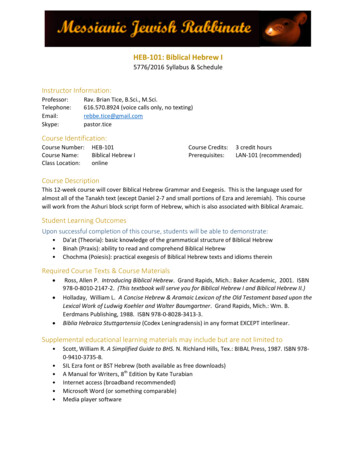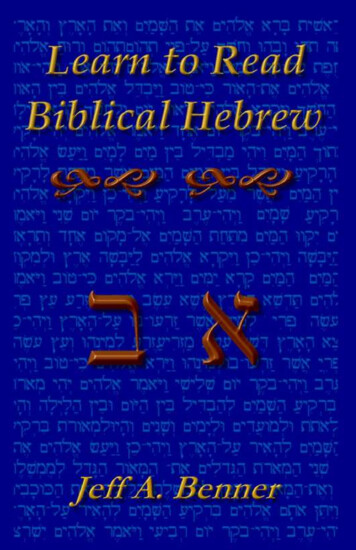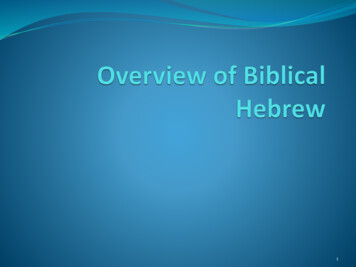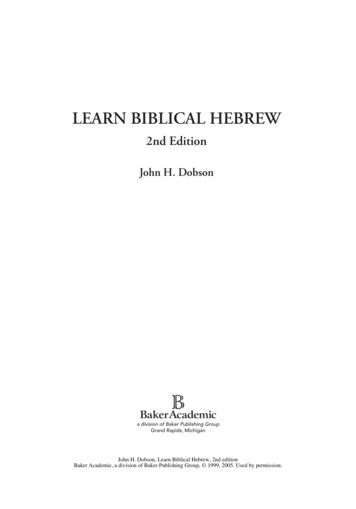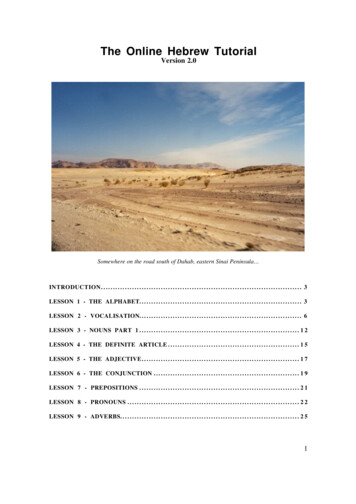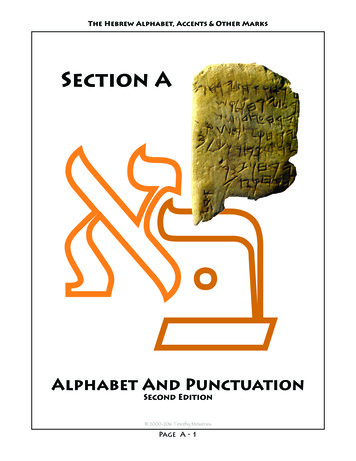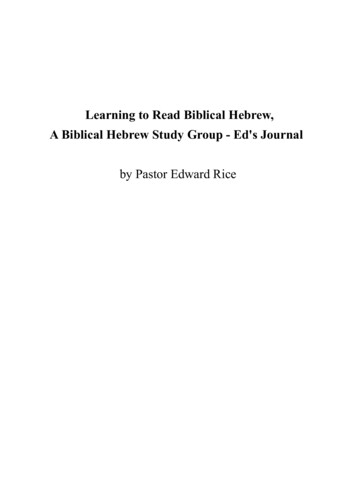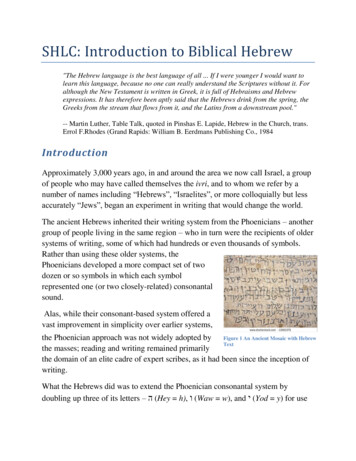
Transcription
SHLC: Introduction to Biblical Hebrew"The Hebrew language is the best language of all . If I were younger I would want tolearn this language, because no one can really understand the Scriptures without it. Foralthough the New Testament is written in Greek, it is full of Hebraisms and Hebrewexpressions. It has therefore been aptly said that the Hebrews drink from the spring, theGreeks from the stream that flows from it, and the Latins from a downstream pool."-- Martin Luther, Table Talk, quoted in Pinshas E. Lapide, Hebrew in the Church, trans.Errol F.Rhodes (Grand Rapids: William B. Eerdmans Publishing Co., 1984IntroductionApproximately 3,000 years ago, in and around the area we now call Israel, a groupof people who may have called themselves the ivri, and to whom we refer by anumber of names including “Hebrews”, “Israelites”, or more colloquially but lessaccurately “Jews”, began an experiment in writing that would change the world.The ancient Hebrews inherited their writing system from the Phoenicians – anothergroup of people living in the same region – who in turn were the recipients of oldersystems of writing, some of which had hundreds or even thousands of symbols.Rather than using these older systems, thePhoenicians developed a more compact set of twodozen or so symbols in which each symbolrepresented one (or two closely-related) consonantalsound.Alas, while their consonant-based system offered avast improvement in simplicity over earlier systems,the Phoenician approach was not widely adopted by Figure 1 An Ancient Mosaic with HebrewTextthe masses; reading and writing remained primarilythe domain of an elite cadre of expert scribes, as it had been since the inception ofwriting.What the Hebrews did was to extend the Phoenician consonantal system bydoubling up three of its letters – ( ה Hey h), ( ו Waw w), and ( י Yod y) for use
as vowels. For example, the Hebrew letter Hey represented not only the consonanth but also the vowel sound /a/1.By representing vowels as specific symbols it became possible to associate somevowel sounds with consonantal sounds by writing a consonant and a vowel sideby-side. This seemingly minor addition made it possible, for the first time, for nonexperts to write. Suddenly, with the Hebrew alphabet, anyone who cared to do socould record their thoughts for posterity.The Hebrew alphabet proved wildly successful. It became the basis for the Greekand Latin alphabets, which in turn were destined to form almost all of the world’salphabets. Even Russian, based on the Cyrillic alphabet, can be traced directly toGreek which, as scholars tell us, derives from Hebrew. With the exception ofcertain Oriental languages (which are non-alphabetic) similar histories characterizesuch disparate languages as, for example, Sanskrit and Arabic – both of whichtrace their roots to Hebrew.The Hebrews’ innovative language set the stage for almost every modern alphabet,and made it possible, for the first time,to make a written record available tothe masses. Their written record, theHebrew Bible, has remained anintegral part of an expanding numberof cultures almost since the time it wasfirst penned, and their language,Hebrew, has flourished throughFigure 2 Joshua 1:1 from the Codex with vowel pointings (about 1000B.C.E)changes its authors could nothave imagined.This course will introduce students to the written language of the ancient Hebrews.By the end of 16 weeks of bi-weekly classes, the student will have acquired theknowledge, skills, and tools necessary to translate accurately much of the Hebrew1In this course it will be sometimes necessary to distinguish between the sound made by a letter, syllable, or wordand its written expression. The standard practice is to bracket the letter (or group of letters) by forward slashes. Forexample, the written letter C has two sounds which we would write as /k/ or /s/ and the pronunciation of the wordcat as /kat/ while the sound of the word cease would be written as /sees/.
Bible and to recognize a number of Hebraisms2 commonly found in the NewTestament (including the famous liturgical greeting, “May the LORD be withyou”3). More importantly, the student will have acquired a profound sense ofappreciation for the richness and depth of God’s word as expressed in writtenHebrew and reflected in the Greek of the New Testament authors.Upon completion of this course, the student will never again read the Bible as he orshe might read a textbook – a kind of book that captures, conveys, and confines itsknowledge usually to a specific time and place. Read in its ancient language, theBible is revealed as a work of intergenerational wisdom, a wisdom expressedlargely through literary art. History and biography are present to be sure, but alsoare the techniques of deep metaphor, poetry, soaring prose, and high drama. Thisaspect of biblical Hebrew is often ignored by all except the scholars who specializein the study if languages and especially how some languages come to bemetaphorical in nature, not descriptive (e.g., Greek and most Western languages).Students will learn that Biblical Hebrew is a metaphorical language, largelybecause its semantics are expressed in concrete terms – terms that are directlyrelated to the five senses4. Because of this characteristic (a characteristic commonto most Semitic languages of the biblical era), some scholars refer to suchlanguages as concrete. Students will learn that when an author has only concretewords to express abstract ideas he must necessarily be metaphorical. For example,the English word authority has no counterpart in biblical Hebrew. To express theidea of authority, the Bible’s authors used metaphor – in this case, the Hebrewword for hand, ( י /yahd/), as in “the hand of God”. Here, “the hand of God”means the authority of God (see, for example, 1Sam 5:11). Ironically, languagesdeficient in their ability to express abstract concepts are often deeply allegorical,metaphorical, and idiomatic. Translating such languages directly (or literally) intomodern, abstract languages such as Greek or English, is a recipe for grossmistranslations. The students’ challenge, therefore, when translating biblical2A Hebraism is a Hebrew phrase expressed – usually literally – in Koine Greek, the language in which the NewTestament was written.3See for example, Exodus 10:10, Ruth 2:4, 1 Sam 17:37, 20:13, 1 Ch 22:11 & 16.4Such languages are sometimes termed concrete because they are characterized by a vocabulary largely lacking inwords that convey abstract ideas. Concrete languages, lacking the words for abstractions, such ideas mustnecessarily be expressed as allegory, idiom, or other symbolic expression.
Hebrew, as they will quickly learn, is to divine the deeper symbolic significance oftheir [initial] literal translations.Whether one is a believer or not; whether one is Christian, Jew, or Muslim – to beable to engage the Bible in its ancient language is to encounter the deep andenduring revelations from God and His will for His creation. In a very real sense,this introduction to biblical Hebrew will reveal to students, perhaps in ways like noother, that even though the Bible was written to the ancient Hebrews it was writtenfor all humankind.Conventions and DefinitionsWe move now from the introduction to (and motivation for) the course, into somehousekeeping.The Purpose of the CourseThe purpose of the course is primarily to equip the student with an understandingof biblical Hebrew sufficient and necessary to use various [well-known andaccepted] Hebrew lexicons and commentaries. For example, the student will,among other skills, be able to decode any arbitrary entry in the famous BrownDriver-Briggs Hebrew and English Lexicon (a.k.a, BDB; see the Appendix in thisdocument for an example page from the BDB). In addition, the student will knowapproximately 50 of the most common words in the Hebrew Bible. This might notseem like much, but the vocabulary of the Bible is not particularly large5 so thateven with this limited vocabulary, much of the biblical text can be understood bycontext – without the aid of a lexicon.Perhaps more important than the language skills, the process of acquiring theseskills will sensitize the student to the issues of translation. When finished, thestudent will have internalized the knowledge that translation is an art, not ascience. It manifestly is not a matter of mapping one Hebrew word into its Englishcounterpart6. Rightly done, a thoughtful Bible study will translate the Hebrew as5The vocabulary of the Hebrew Bible is relatively small. It uses about 25% of the vocabulary used by Shakespeareand approximately 1% of the words found in the Oxford English Dictionary. Moreover, many of its words are usedless than 10 times and many are names and proper nouns.6In many, many cases (possibly the majority of cases), such mappings simply do not exist. The lack of word-toword mapping is why many teachers caution their students when using Hebrew-English interlinear Bibles.
understood by the ancient Hebrews (to whom the Bible was written) into Englishideas understood by contemporary, Western culture (for whom the Bible waswritten).The HebrewThe examples used throughout the course are taken from the biblical Hebrew textof the Masoretic Text from the Biblia Hebraica Stuttgartensia (1977) or MT forshort. The MT is available online and in a number of excellent Hebrew bibles. Alist of on-line sites, reference Bibles and printed texts will be provided to eachstudent.Learning a New Language – The Problem of ExceptionsAll languages are governed by grammatical rules – rules that tell us, for example,how to express actions, ownership, gender (if present), among other rules.Unfortunately for the student, all rules in all languages have exceptions. In mostbiblical Hebrew courses with which I am familiar, the accompanying grammartextbooks present the grammatical rules along with their exceptions.But this is not how native languages are learned. When a three year old is firstlearning to read (or speak), he or she is not exposed to parts of speech, verbalconjugations, how to distinguish between subjective and genitive expressions.Rather, beginner books (and other beginning language materials) take care to usesimple, normative grammar leaving the exceptions for later in the child’seducation.Yet this is not how foreign languages are taught. Here’s just one example; inone of the most popular (and one of the best – in my opinion) biblicalHebrew Textbooks7, the rules for recognizing plural nouns are clearlyexplained along with all the exceptions to those rules.This practice is not followed in this course. Rather, the content has been carefullyselected to employ and to exemplify the regular, normative grammar. I recognizethat there are occasions in which it is important for the student to know thatexceptions exist, but those exceptions will be dealt with when they arise. The7Pratico, Gary D. and Van Pelt, Miles V., “Basics of Biblical Hebrew: Grammar”, Zondervan, Grand Rapids, MI,2001
student will not be burdened by grammatical issues he or she will, in all likelihood,only rarely encounter.Which brings us to the issue of biblical examples.All examples are taken from the biblical Text. In some cases I will have simplifiedthe example text for clarity, but not meaning. One example of this is the use of thereduced Hateph vowels. These vowels do not change the meaning of the words inwhich they occur and only change the word’s pronunciation very slightly. Forthese vowels the student will be instructed to treat them simply as their nonreduced counterparts. For example, we will almost always read the Hateph-Patachas a simple Patach for the purposes of translation.Since this is a religiously oriented course, many of the Hebrew examples will havebeen chosen not only for illustrative purposes, but for their theologicalsignificance. Accordingly, we will take time to tease the theology from the Hebrewsemantics where we can. This, it turns out, is a lot of fun and students really seemto enjoy this aspect of the course.Transliteration, Transcription, TranslationTransliteration refers to the process of converting the text of one language into thetext of another. Transcription8, by contrast, is a process by which the sounds of onelanguage are expressed in another. Translation is the process of converting themeaning of the text in one language to its proper expression in another.The symbols used to transliterate between languages are standardized, highlyformalized, and would impose an additional layer of difficulty on students that islargely unwarranted for Bible study. Sadly, most textbooks and educational websites use transliteration when transcription is what is actually meant. In this classwe will not use the term transliteration when we really mean transcription. In fact,transliteration, rightly understood, is simply not part of this class.Now, and just to reinforce this point, here is the Hebrew text of Genesis 1:1 alongwith its transliteration, its transcription , and its translation (NOTE: Hebrew is readfrom right-to-left):8Actually, there are two forms of transcription, phonetic (based on sounds) and orthographic (based on letters). Thisclass uses a much simplified phonetic transcription system.
HebrewTransliterationTranscriptionTranslation ָָארץ ֶ ְואֵת ה ש ַמי ִם ָ ב ָָרא אֱֹלהִים אֵת ַה ב ְֵראשִית hä äºrecwü ët haššämaºyim ët élöhîmBärä Bürë ndthe-heavensGodcreatedbəreishitWhenbeginningIn this course, I will try to use whatever English letters best describe thepronunciation. Sometimes the English will mimic the letters that comprise theexamples and sometimes the sounds. Because of this utilitarian approach, thetranscriptions used in this course are those that simplify a concept. Where atradeoff between simplicity or clarity versus standardized usage is concerned, wewill favor simplicity and clarity always.Now, go and study
AppendixAn arbitrary page from the written BDB
of biblical Hebrew sufficient and necessary to use various [well-known and accepted] Hebrew lexicons and commentaries. For example, the student will, among other skills, be able to decode any arbitrary entry in the famous Brown-Driver-Briggs Hebrew and English Lexicon (a.k.a, BDB; see the App
